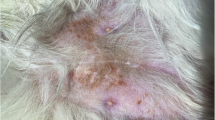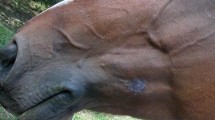Abstract
Cutaneous candidiasis involving the foot pads of 5–30 weeks old Japanese quails was recorded in a large quail breeding unit. Histopathological lesions comprising granulomatous reaction in the dermis and hyperkeratosis resembled with those of candida granuloma of human beings. The causative fungus, isolated from the foot pad lesions on Sabouraud agar, was identified as Candida albicans on morphological and biochemical characteristics. Predisposing factors such as overcrowding and un-sanitary conditions were found to be apparently responsible for candidiasis in quails. These factors when taken care of resulted in a marked decrease in the disease incidence. This appears to be the first report of cutaneous candidiasis in avian species.
Similar content being viewed by others
References
Blaxland, J. D. & Fincham, I. H., 1950. Mycosis of the crop (moniliasis) in poultry with particular reference to serious mortality occurring in young turkeys. Brit. Vet. J. 106: 221–231.
Duguid, J. P., 1965. Pathogenic Fungi, in Medical Microbiology 7th ed. pp. 517–523. Ed. R. Cruickshank. E. & S. Livingstone Ltd.
Gentry, R. F., Bubash, G. R. & Chute, H. L., 1960. Candida albicans in turkeys. Poult. Sci. 39: 1252.
Hauser, F. V. & Rothman, S., 1950. Monilial granuloma-Report of a case and review of the literature. Arch. Dermatol. 61: 297–310.
Jungerman, P. F. & Schwartzman, R. M., 1972. Veterinary Medical Mycology, pp. 61–74. Lea and Febiger, Philadelphia.
Kral, F. & Uscavage, J. P., 1960. Cutaneous candidiasis in a dog. J. Amer. Vet. Med. Ass. 136: 612–615.
Kuttin, E. S. & Beemer, A. M., 1975. Fungi isolated from birds and animals in Israel, in Recent Advances in Medical and Veterinary Mycology. Ed. Kazuo Iwata. pp. 151–155. University Park Press, Baltimore.
Manual of Histologic and Special Staining Technics 1960. 2nd ed. Armed Forces Institute of Pathology. McGraw-Hill Book Co., New York.
Reynolds, I. M., Miner, P. W. & Smith, R. E., 1968. Cutaneous candidiasis in swine. J. Amer. Vet. Med. Ass. 152: 182–186.
Rippon, J. W., 1974. Medical Mycology. The Pathogenic Fungi and the Pathogenic Actinomycetes. pp. 177–204. W. B. Saunders Co., Philadelphia.
Schwartzman, R. M., Deubler, M. J. & Dice, P. F., 1965. Experimentally induced cutaneous moniliasis (Candida albicans) in the dog. J. Small Anim. Pract. 6: 327–332.
Wildra, A., 1957. An improved fermentation method for rapid identification of Candida species. J. Infect. Dis. 100: 70.
Author information
Authors and Affiliations
Rights and permissions
About this article
Cite this article
Sah, R.L., Mall, M.P. & Mohanty, G.C. Cutaneous candidiasis in Japanese quail (Coturnix coturnix japonica) . Mycopathologia 80, 33–37 (1982). https://doi.org/10.1007/BF00437176
Issue Date:
DOI: https://doi.org/10.1007/BF00437176




